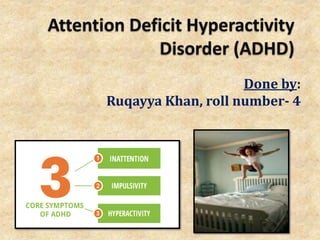
ADHD Signs, Causes, Diagnosis and Management
- 1. Attention Deficit Hyperactivity Disorder (ADHD) Done by: Ruqayya Khan, roll number- 4
- 2. Attention Deficit Hyperactivity Disorder (ADHD) is one of the most common neurodevelopmental disorders of childhood. It is characterized by problems paying attention, excessive activity, or difficulty controlling behavior which is not appropriate for a person's age. It’s more common in boys than in girls. It’s usually discovered during the early school years, when a child begins to have problems paying attention. ADHD often persists into adulthood, with resultant impairments of social, academic and occupational functioning. In children, problems paying attention may result in poor school performance.
- 3. Signs and Symptoms: Inattention: children who are inattentive find it difficult to sustain mental effort during work or play. They have a hard time keeping their minds on any one thing or in following instructions. Common complaints are that the child does not listen, cannot concentrate, does not follow instructions, is disorganized, easily distracted, forgetful, does not finish assignments and is quick to lose interest in boring activities.
- 4. Impulsivity: children who are impulsive seem unable to control their immediate reactions or to think before they act. They find it difficult to wait or take turns, have difficulty resisting immediate temptations or delaying gratification. Hyperactivity: children with ADHD are in constant motion. Sitting still through a lesson is impossible for them. The child may fidget, squirm, climb and run around the room aimlessly. Parents and teachers describe them as ‘driven by a motor’.
- 5. As with many other psychiatric disorders, formal diagnosis should be made by a qualified professional based on a set number of criteria. In the United States, these criteria are defined by the American Psychiatric Association in the DSM. Based on the DSM criteria, there are three sub-types of ADHD: 1. ADHD predominantly inattentive type (ADHD-PI) presents with symptoms including being easily distracted, forgetful, daydreaming, disorganization, poor concentration, and difficulty completing tasks. 2. ADHD, predominantly hyperactive-impulsive type presents with excessive fidgetiness and restlessness, hyperactivity, difficulty waiting and remaining seated, immature behavior; destructive behaviors may also be present. 3. ADHD, combined type is a combination of the first two subtypes. This subdivision is based on presence of at least six out of nine long-term (lasting at least six months) symptoms of inattention, hyperactivity–impulsivity, or both. To be considered, the symptoms must have appeared by the age of six to twelve and occur in more than one environment (e.g. at home and at school or work). Diagnosis of ADHD:
- 6. Causes of ADHD: The cause of ADHD isn’t known. Researchers say several things may lead to it, including: Heredity-ADHD tends to run in families. Chemical imbalance - Brain chemicals in people with ADHD may be out of balance. Brain changes-Areas of the brain that control attention are less active in children with ADHD. Poor nutrition, infections, smoking, drinking, and substance abuse during pregnancy. Toxins, such as lead. They may affect a child's brain development. A brain injury or a brain disorder - Damage to the front of the brain, called the frontal lobe, can cause problems with controlling impulses and emotions. Research does not support the popularly held views that ADHD is caused by eating too much sugar, watching too much television, parenting or social and environmental factors such as poverty or family chaos.
- 7. Management of ADHD: The management of ADHD typically involves counselling or medications either alone or in combination. While treatment may improve long-term outcomes, it does not get rid of negative outcomes entirely. 1. Behavioral therapies: They are the recommended first line treatment in those who have mild symptoms or are preschool-aged. Psychological therapies used include: psycho-educational input, behavior therapy, cognitive behavioral therapy (CBT), interpersonal psychotherapy, family therapy, school-based interventions, social skills training, behavioral peer intervention, organization training, parent management training, and neurofeedback. 2. Medication: Stimulant medications are the pharmaceutical treatment of choice. They have at least some effect on symptoms in the short term in about 80% of people. Stimulants may also reduce the risk of injuries in children with ADHD. There are a number of non-stimulant medications too that may be used as alternatives, or added to stimulant therapy.
- 8. 3. Exercise: The long-term effects of regular aerobic exercise in ADHD individuals include better behavior and motor abilities, improved executive functions (including attention, inhibitory control, and planning, among other cognitive domains), faster information processing speed, and better memory. 4. Diet: Eating a healthy diet centered on fruits, vegetables, whole grains, legumes (for example, beans, peas, and lentils), lean protein sources, and nuts and seeds is also beneficiary. In conclusion, ADHD is a debilitating disorder for those diagnosed as well as the families, as it can lead to academic problems, social exclusion, comorbidity with other psychiatric disorders and criminal behaviour.